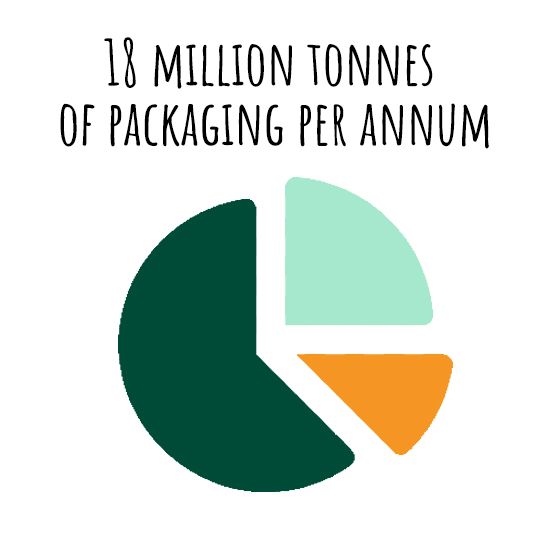Our sustainable and eco-friendly packaging solution
When it comes to sustainable products, more and more attention is being placed on the topic of eco-firendly packaging. It also represents an opportunity for us to pack our feed as sustainably as possible. This is a real challenge, but one that we take on with confidence. For everything about the current status of our packaging and what we still have in store, read the following article.

Let's start with a few facts and figures: In Germany, about 18 million tonnes of packaging are used annually - 2/3 of which in the area of food, beverages and pet food.
71 % (by mass) is recycled for materials and 27 % for energy. In the case of energy recovery from waste, the main purpose of the recovery is to use the waste and not, as in the case of thermal treatment, to eliminate its pollutant potential. 2 % is not recovered (360,000t). Slightly less than 50 % of raw materials of fossil origin are recycled.
Plastic - a threat to wildlife, the oceans and humans?
Plastic is present everywhere: we come into contact with this material every day. They may be useful but also create tremendous damage if they are not properly disposed of. This is because plastic waste forms entire islands in the sea, thus harming our environment, animals and us.
It has been estimated that our plastic waste kills up to 140,000 marine mammals and one million seabirds every year. Birds mistake plastic for natural food, dolphins get caught in old fishing nets and turtles get entangled in packaging; the scenarios are endless. The animals starve to death with full stomachs because plastic clogs their digestive system and when trying to disentangle themselves from the nets, they drown or suffer serious injuries.
Plastic waste has become a real threat and has changed our planet. About 50 years ago, we produced only about 1.5 million tonnes of plastic per year, today we are talking about more than 400 million tonnes. A large part of this ends up in the oceans. Almost 75 % of all the waste in our oceans is plastic. According to the United Nations Environment Programme (UNEP), there are up to 18,000 pieces of plastic floating on every square kilometre of ocean surface. And that is only the evident part as more than 90 % of the rubbish sinks to the bottom of the ocean.
Plastic in the sea remains in the sea because it decomposes only slowly and the sun causes small pieces of it to break off little by little. The decomposition processes release harmful constituents such as bisphenol A and phthalates, which accumulate in the food chain and alter the genetic make-up and hormonal balance of marine animals. This can also lead to long-term damages for us humans. In many cosmetic products plastic particles are detected that we eventually ingest. Every year, several thousand tonnes of microplastics end up in the sewage system and sooner or later find their way back to us.
The good side of plastic
Plastic should not be demonised completely, however, because it also offers advantages. For example, it has a high degree of hardness, is elastic, temperate-resistant, odourless and break-proof. We need it in medicine for syringes, infusion bottles and blood bags. We can use it to protect medical products from dangerous germs. We also use plastic to prolong the shelf life of our food and protect it from harmful environmental influences.
Plastic is also vital for the generation of solar and wind energy. Therefore, not only can we harm the environment with plastic, but it also helps enable us to generate sustainable energy.
It is important to use plastic properly and sparingly. If we try to use plastic only where it will do more good than harm, we can continue to benefit from the advantages of this material in the future.
Responsible use
Plastic is durable and is therefore naturally used in many areas of our everyday life, especially in the area of packaging. The problem lies in precisely those plastic products that we only use for a short moment, such as plastic carrier bags or take-away coffee cups. It is precisely these items that lead to growing mountains of waste and damage the environment.
Recycling plastic waste is therefore important. Even better is to avoid plastic in disposable products altogether. Reusable bottles and cotton carrier bags are alternatives. Meanwhile, you can also find “bulk stores" where you can bring along your own containers and fill them with foodstuffs such as rice or nuts.
Also, the use of cardboard or paper is generally better than plastic - but even then it is only more resource-efficient if it is recycled. That is because the production of paper naturally also consumes energy, so paper should be disposed of properly in order for it to be reused.

Growing awareness for sustainability
Companies are focusing more and more on the topic of sustainability. A shift in thinking is taking place slowly but surely and is gaining momentum through information and education. Many companies are thinking about how they can act more sustainably, and of course the packaging of their products is also involved.
At Green Petfood, we have focused on sustainable packaging from the very start. All our products are selected and manufactured with aspects of sustainability in mind. We attach great importance to the origin and quality of our ingredients. We also want to reflect this approach with our packaging and have given thought to how we can package our pet food from the very beginning.
What is our Green Petfood packaging made of?
Our large dry pet food packages are made of paper on the outside with a thin plastic composite on the inside. This ensures that the flavour remains intact, the shelf life is preserved, transport is safer and the product is protected.
We place great importance on the packaging of our products, and as a sustainable company, we are always on the lookout for solutions and improvements to make it even more eco-friendly. In so doing, however, we must always ensure that our packaging is user-friendly and, above all, that the quality of the ingredients is guaranteed for you and your four-legged friend. At the same time, we want to ensure that our packaging is recyclable and free of harmful substances. Since we also want to reduce our CO2 emissions in the area of packaging step by step, we focus on using as little material and as little plastic as possible. We prioritise renewable and recyclable raw materials, and in the future we aim to replace plastics with eco-friendly sustainable plastics.
Paper packaging with vapour barrier made of HDPE film
This material should be disposed of in the paper waste bin, the plastic film is either separated from the paper or is used in the production of corrugated cardboard.
Paper/plastic composite
In this case, a new type of paper/plastic composite is used. It enables us to use a digital printing process and to minimise the amount of plastic. This material should be disposed of in the bin for recyclable waste, the paper content is separated accordingly.
Plastic composite
Our pouches are made of a plastic composite. No paper can be used because the pouches are autoclaved (sterilised with steam) to make them long-lasting. In this way, however, we can entirely dispense with the addition of preservatives! The composite is made with the minimum amount of material possible. We are in the process of testing new materials to become more sustainable in the future.







